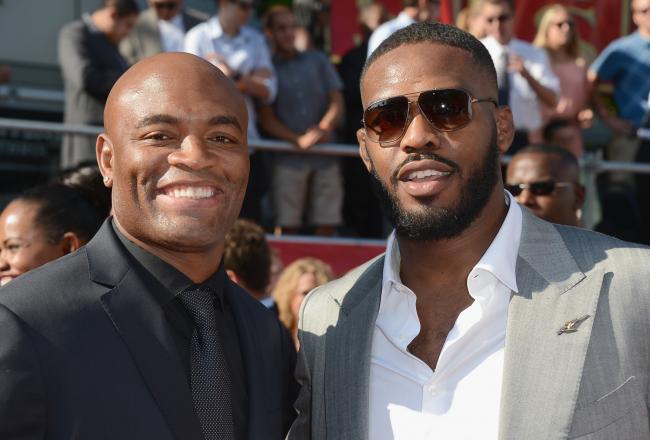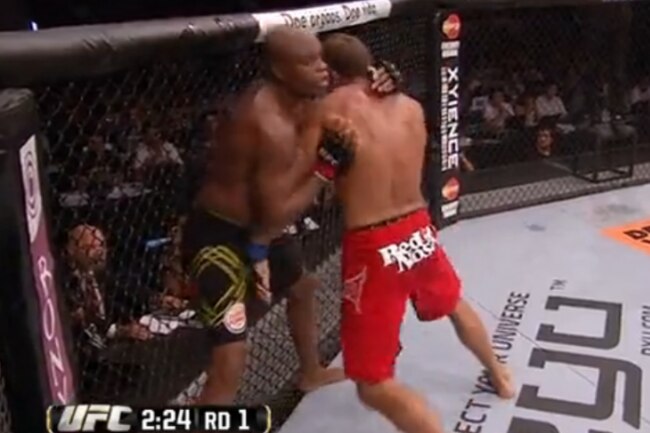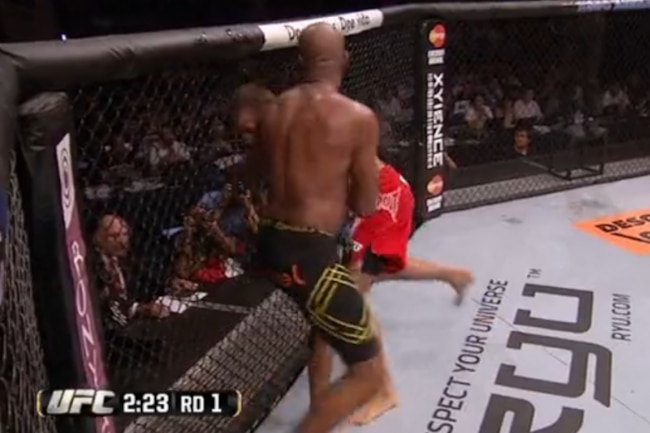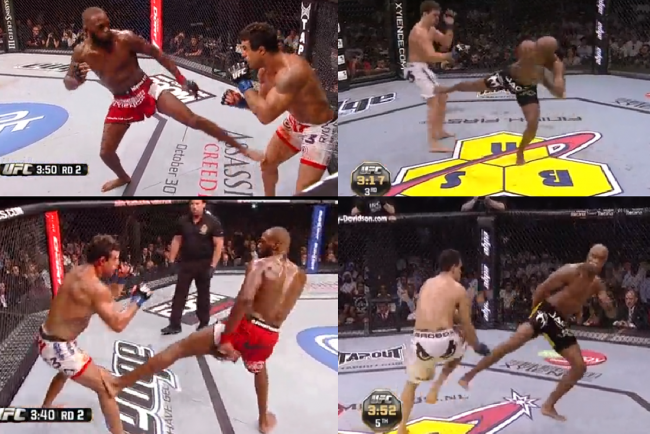
I am not a fan of the idea of the champion versus champion superfights that every MMA journalist seems to be talking about.
It seems that everyone in the MMA world wants to pretend that the arduous weight cuts which fighters put themselves through are purely formalities, and that fighters who work their hardest to fight as the biggest men in their weight classes would happily go up and have no problem against the champion in the class above.
While the superfights are never going to happen because they are simply terrible business strategy, I have received an awful lot of requests to look at the hypothetical variables of a bout between UFC middleweight demigod Anderson Silva and young light heavyweight champion Jon Jones.
As a preface, Anderson Silva is the greatest striker in MMA, and I wholeheartedly believe that.
Unfortunately, a good striker will not pretend reach, size and the availability and risk of a tie-up mean nothing. If you are expecting an article where I hype up both sides and end with "this really is anyone's fight," you are going to be heartbroken.
Wrestling
It should be no secret that Jon Jones will have a definitive advantage in the wrestling department.
Not only is Jones known as the best wrestler in his division, but Silva's most obvious Achilles' heel is his difficulty in stopping takedowns from elite takedown artists. While Silva had some success against Chael Sonnen in stopping takedowns—albeit with some grabbing of Sonnen's shorts—Jones will also have a massive size and strength advantage.
Much of Silva's success against wrestlers who enjoy getting takedowns from the clinch (such as Yushin Okami) has come from his use of a striking-based counter-clinch.
Silva will place his back to the fence and work to get his forearms in front of his opponent's collar bones in order to take a double collar tie on the neck and work for separation and the space to land his brutal knees to the rib cage.
Jones' work from the clinch is also excellent. He combines his brilliant trips and balance breaks with opportunities to break away and strike. A staple of the Jones game which we have seen numerous times is his placing an opponent's back on the fence, pushing under their chin with one or both hands to pin them in place and create space and then spinning for an elbow strike.
While Anderson Silva had the technique to counter natural 205-pounder Stephan Bonnar's strength, Bonnar was not a very good wrestler or striker. Every time Bonnar leaned on Silva, Silva would pop Bonnar's head up with a shoulder bump or turn Bonnar into the fence and connect a hard knee.
Jones, meanwhile, is technically elite in both regards, in addition to being a huge 205-pound fighter.

Bonnar leans on Silva.

Silva steps out to his right and throws Bonnar face first into the fence.
Much of Silva's ability to stay off of his back in his bouts since entering the UFC has come not from his actual counter wrestling, but from his positioning and footwork.
While Silva has improved exponentially as a fighter since his days in PRIDE and Shooto, fighting in a ring really worked to his disadvantage. In the cage, there are no significant corners, and Silva can move around freely without hitting a wall unless he is physically pushed on to it.
Cutting off the cage is still a poorly practised skill all around in MMA, but Jones has shown to be at least decent at it. He managed to move Lyoto Machida—almost identical to Silva in his use of footwork to take away the possibility of takedowns—onto the fence with a well-placed slip and clinch.
Gif of that here:

Silva has been able to back-track for 25 minutes before when he doesn't want to engage at close quarters—just look at his bout with Demian Maia.
But Maia's understanding of the striking game is limited entirely to knowing how to throw a decent roundhouse kick. If the slow-moving Yushin Okami can get Anderson Silva to the fence with nothing to serve as a threat but his predictable jab, it is safe to assume that Jon Jones—who has a complete tool kit on the feet—can as well.
I think it is safe to assume that once the bout hits the ground, it is Jones' fight to lose. His ground-and-pound is unmatched in MMA at present, and Silva's only real defence from guard against good ground-and-pounders is usually to lock in a body triangle with his legs (something which is unlikely to work against a man as large as Jones), tie up the opponent's hands and stall out.

Jon Jones is far removed from Chael Sonnen, who seems to strike for appearance on the ground more than effectiveness. Jones's few elbows on the ground against Lyoto Machida completely destroyed his composure in moments.
Weathering the storm against Jones on the ground is not an option. Unlike Chael Sonnen, Jones is not prone to tiring himself out and getting submitted.
Striking
To me, this is really the be-all and end-all of this hypothetical. So many of those who actually hope this match will take place are deluding themselves that while Jones has the edge on the ground, Silva should have the edge on the feet.
To anyone who has really thought about it at length it is obvious that Silva does not.
Silva is arguably the best boxer in MMA to date—his tactics on the feet are brilliant as he draws strikes and counters with ease—but he is a fighter who almost always fights with a reach advantage and really uses it.
Against grapplers, it is particularly important to Silva that he has a good reach advantage, because when he flat-out doesn't want to engage, he will go to long jabs and the side kicks to the knee joint and low kicks to the calf—hard kicks to catch, but easy ones to throw.

Anderson's entire game is also about making his opponent come to him. Anyone who has watched his bouts with Thales Leites or Patrick Cote will know that Silva hates to lead. Silva will get ahead on the scorecards with long, flashy strikes in order to force his opponent to come forward—at which point he can begin his famous counterpunching.
Unfortunately, all of the tactics which Anderson uses to keep his range against grapplers and force opponents to attack him with strikes are in Jones' arsenal, and Jones uses them just as well as Silva. Think about how easily Jones used his strikes to the knee joint to keep Vitor Belfort, Quinton Jackson and Rashad Evans from closing the distance on him.

This would be a match where Anderson Silva would be the man forced to close the distance—all the while avoiding the clinch—and that is something we have very rarely seen him do. Against Forrest Griffin, Silva took a rare moment of offensive action as he pressured Griffin backward, then hit him with a right hook as Griffin circled out. That was simply sublime.
Gif of that here:

But why would Jon Jones, who would actively want to clinch, retreat from Anderson's jabs?
What Silva would need to do to win is exactly what Machida did so well against Jones—the Kyotaro/Machida strategy. Back up and run until the opponent over-commits, and jump in with a power punch to meet them.
http://www.youtube.com/watch?feature=player_embedded&v=aRuivw7sPe4
Now there's nothing to stop Silva doing this. He's the best striker in MMA—I'm sure he could pick it up in five minutes of sparring. But the problem is that in using this sort of strategy, one will still end up in clinch range whenever one steps in.
In David vs. Goliath matches in boxing (such as David Haye vs. Nikolai Valuev or Manny Pacquiao vs. Antonio Margarito) or kickboxing (such as Kyotaro vs. Semmy Schilt/Peter Aerts), the smaller fighter can back up and run until he wants to step in, then clinch if he doesn't hurt his opponent and the referee will simply break them.
In MMA, that clinch will mean the bigger fighter can push to the fence and start beating the smaller fighter up.
Conclusions
He who controls the range controls the fight, and both Silva and Jones have used their side kicks and oblique kicks to the knee joint and footwork to amply demonstrate that point in the past.
Unfortunately, with the massive height and reach advantage that Jones would boast against Silva, it is easy to see him out-pointing The Spider early with the sort of tactics that Silva uses himself to get ahead on the score cards.
Silva would be forced to close the distance, and in this he is no more proven than Quinton Jackson or Rashad Evans were. He certainly has not shown the same ability to close the distance against opponents that Vitor Belfort has, and Belfort could get nothing going against Jones.
Now with head movement and footwork as good as Silva's, it shouldn't be impossible to perform the difficult task of learning a completely new method of fighting. But once Silva closes the distance, he is still in trouble. In boxing if you get inside an opponent's reach, he has nothing except the clinch. Jones' elbows are still among the most savage strikes in MMA, and he's happy to jam them in the face of his shorter opponents in their own punching range.
Finally, if Jones did want to clinch after the distance was closed, there is very little to suggest Silva could stop the takedown or the ground-and-pound assault. It is notable that Silva's only fights at light heavyweight have been basically exhibitions against opponents who are not gifted wrestlers, but "scrappy" guys who were there to engage Silva.
Jon Jones represents a taller, heavier fighter who is good enough at the reach-abusing tactics which Silva loves that he can stop Silva closing the distance and beat him up at range.
In addition to being a hard man to handle on the feet, however, Jones's greatest strength is in the area of Silva's greatest weakness—he is an extremely strong and skilled wrestler who routinely stops opponents on the ground.
If Silva couldn't stop the takedown—and the evidence suggests he couldn't—he would not be able to bide his time from the bottom, and elite as his ground game is, he simply doesn't have the kind of guard which will allow him to submit or sweep Jones whenever he wants.
Obviously a fight is a fight, and if Silva did overcome these physical disadvantages and learn an entirely new method of fighting after however many years, he would be the greatest fighter of all time, no doubt. Unfortunately, experience and good sense strongly side with Jon Jones and the idea that bigger, but equally talented, is better.
Ultimately, weight classes exist for a reason, and Jon Jones and Anderson Silva go through arduous weight cuts for the same reason. Currently the MMA media is enjoying playing up the delusional idea that the UFC would sacrifice one of its unbeatable champions to the other for one night of good pay-per-view sales.
Instead, the hype surrounding the possible superfight just serves to make more fans tune in to view mismatches such as Silva vs. Bonnar and Jones vs. Sonnen.